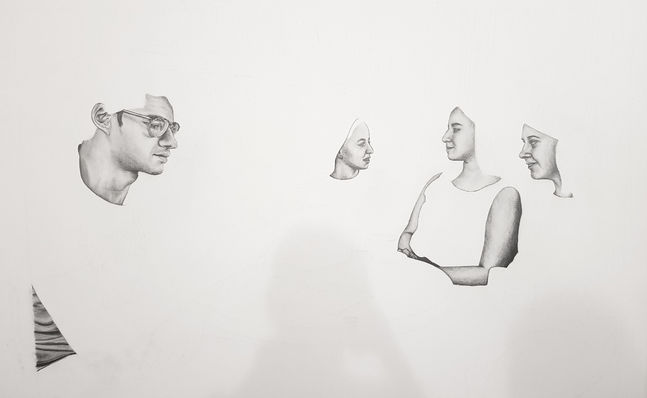Misconception
Being given the freedom to conduct a project with any chosen theme enabled me to pursue something personal whilst experimenting with a range of concepts and media. I, therefore, decided to explore the importance of trust and dependency within relationships. Questioning myself, and the audience whether I truly can trust those around me. The project resulted in a mixed media piece of drawing and projection with the intention of forcing the audience to question not only their own vision but that of the trust they place in others.
^Both original and 'glitch' drawing edited in a video to be projected over the larger drawing.
I believe that you can never 100% know or understand an individual unless being able to read their mind and emotions. This, for me, creates a detached, uncomfortable and unchangeable feeling. Anyone you meet, whether that be your parents, friends or partner, would have lived a life before/separate to you. Although they can recount stories to you a thousand times, unless there, or experiencing it from their point of view, you will never fully be a part of their life. This then leads me on to question how well you can, therefore, trust someone.
Placing your trust in someone is an important factor when building strong relationships with people. There have been countless times however when people, including myself, have put my trust in the wrong individual, with outcomes that can often be damaging. Something the audience may be able to relate to. I, therefore, wanted to encourage the audience to question their knowledge of those they hold close, and the levels of trust they may place in certain people.

^Original Drawing. Graphite Pencil on Fabriano paper, 38"x58", 2019
I studied the work of artists' Sam Taylor-Johnson, Dan Wheatley, Robin Eley, and Jeff Wall. My work was developed heavily throughout the project, with various different ideas combining to result in my chosen multi-media piece. Having trouble conveying a sense of mistrust through a two dimensional, stationary image, I, therefore, decided to explore the work of Dan Wheatley to consider using projection to combat this problem. This further led me to the oeuvre of Sam Taylor-Johnson who often creates subtle movements in her videos to make the audience question whether what they are looking at is stationary or not. Can they trust their own vision?
^Progress images of the drawing
Having originally intended on using moving figures in the projection, I altered my idea to a video inspired heavily by the work of Taylor-Johnson. A separate drawing of two figures (finished to the same standard as the larger drawing) is displayed for a split second over the original drawing in a 'glitch'. This not only plays tricks on the viewers in a similar way to that of Taylor-Johnson's work but introduces the importance of technology.
Technology can easily manipulate the truth and create a partial image of something. This can therefore easily misguide people and harm them whether that be through catfishers or misinformation. The 'glitch' shows the ability for technology to malfunction and show an alternative image.
Although putting in around 30 hours of work to create a highly realistic detailed drawing, I decided to leave the piece incomplete. Leaving the drawing unfinished represents how technology can delete and erase important information, whilst further suggesting our inability to know someone 100%. How can you trust someone you can't fully know/understand or see?





^Sketchbook experiments and details from the drawing
^Video projected over the drawing. Some alignment issues due to lack of time and equipment to perfect in my next project








